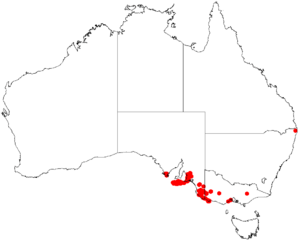Lepidosperma canescens facts for kids
Quick facts for kids Lepidosperma canescens |
|
|---|---|
| Scientific classification | |
| Genus: |
Lepidosperma
|
| Species: |
canescens
|
 |
|
| Occurrence data from AVH | |
Lepidosperma canescens (common name hoary rapier-sedge) is a sedge of the family Cyperaceae that is native to south-east South Australia and Victoria. There are no synonyms.
Description
Lepidosperma canescens is a clump-forming perennial with short rhizomes. It has terete, rigid, erect, and smooth culms which are 25–100 cm by 0.8–2.0 mm. The leaf-blades are similar to the culms but usually shorter and from 0.7–2 mm in diameter. The sheaths are yellow-brown to dark grey-brown, and are sometimes a dark reddish near the apex. They are not sticky. The inflorescences are fan-shaped to oblong. They are loose, erect, and 3–8 cm by about 2 cm. The involucral bract is shorter than the inflorescence. The spikelets are 5–7 mm long. The nut is obovoid (2–3 mm by 1.0–1.3 mm), and brown, smooth, and shining.
Uses
This sedge was used by Aborigines for weaving artefacts, and is used by the aboriginal artist, Yvonne Koolmatrie, for her weaving.

